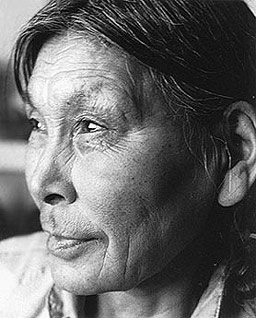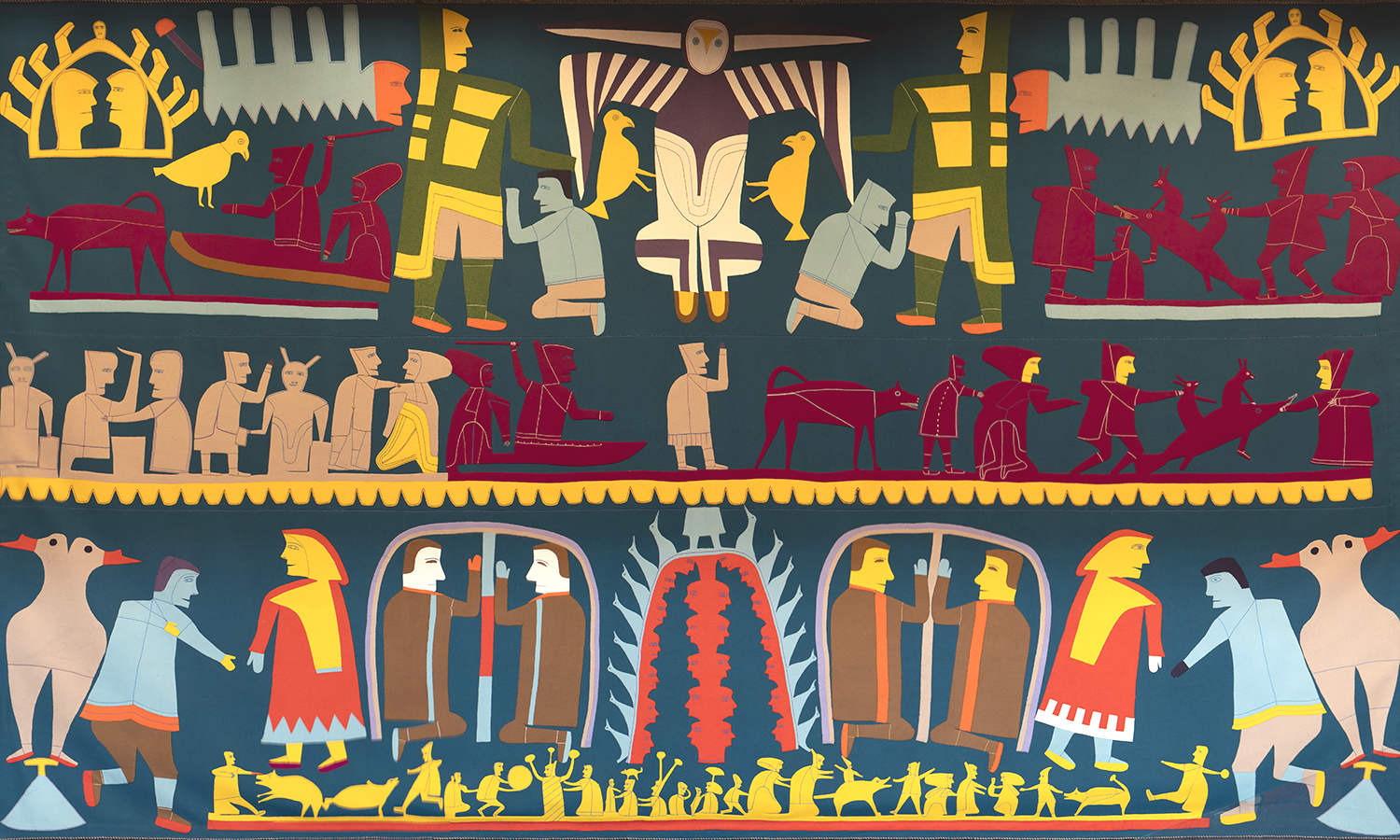Jessie Oonark, Untitled Tapestry
Learn about Jessie Oonark’s life, how the tapestry made its way into the NAC, and the history of Inuit art.
Jessie Oonark was born in 1906, in the Chantrey Inlet. At fourteen she married and went on to have eight children. At 47, her husband died, leaving her with two children still at home to care for. She struggled without an income, before discovering her passion for art.
Click image for full size. Photo by Joe Creech and Eddie Benhin

Oonark was inspired by students in her hometown to take up art. Her work quickly came to the attention of James Houston, who helped her sell prints through an artist co-operative. By 1973, she had gained international recognition for her work, and was commissioned by Bill Teron to create the tapestry that now hangs in the NAC foyer.
Inuit Art
Inuit art dates back thousands of years to the beginning of human history in North America. Knowledge of ancient Inuit art comes from found artifacts, and stories and traditions passed down to generations of Inuit peoples. Inuit art ranges from 3D sculptures to 2D drawings, prints, and tapestries. A surge in the popularity of Inuit art happened in the 1960s when Inuit art co-operatives helped artists produce prints and other profitable art.
Untitled Tapestry at the NAC
Bill Teron originally commissioned Jessie Oonark’s tapestry for one of his buildings, but it was too big to fit anywhere nicely. At a social gathering with the NAC board of directors, he showed off the tapestry, and they decided to hang it in the foyer of the NAC, accompanied by a huge unveiling attended by Jean Chretien, the Prime Minister at the time.
Unfortunately, there was no contract between Teron and the NAC so after his death, his family reclaimed the tapestry. After negotiations with the Teron family, the NAC restored the tapestry and reinstalled it in 2013.
Some of Jessie Oonark’s Other Artworks
Jessie Oonark was a successful artist in a variety of mediums. She began with drawings before moving to prints with the help of artist co-operatives. Toward the end of her career in the 1970s and 1980s, she made large tapestries and wall hangings with wool and felt. Her work is characterized by its flat, bright colours, and a mix of Inuit and Catholic symbolism.
Discover Inuit Art. (2016) Government of Canada. https://www.rcaanc-cirnac.gc.ca/eng/1303132857502/1534961334399
Inuit Art. (2016) The Canadian Encyclopedia. https://www.thecanadianencyclopedia.ca/en/article/inuit-art
Inuit Co-operatives. (2013) The Canadian Encyclopedia. https://www.thecanadianencyclopedia.ca/en/article/inuit-co-operatives
James Archibald Houston. (2013) The Canadian Encyclopedia. https://www.thecanadianencyclopedia.ca/en/article/james-archibald-houston
Jessie Oonark. (2015) The Canadian Encyclopedia. https://www.thecanadianencyclopedia.ca/en/article/jessie-oonark
Simpson, Peter (2013) Jessie Oonark Tapestry at National Arts Centre in Ottawa, Ontario. https://www.youtube.com/watch?v=Lu4vAt-niRc
McGhee, Robert and Sutherland, Patricia D. (n.d.) Lost Visions, Forgotten Dreams. Canadian Museum of History. https://www.historymuseum.ca/cmc/exhibitions/archeo/paleoesq/peexheng.html
The History of Inuit Art. (2017) Vincent Art Gallery. https://galerievincent.wordpress.com/2017/06/02/the-history-of-inuit-art/
Special thanks to Robert VanderBerg
Project Disclaimer and Thank You
The Art@NAC project is a student assignment within MPAD2002: Basics of Visual Communication. Research, narratives, and development are conducted by Bachelor of Media Production (BMPD) 2nd-year students at Carleton University and it is not an official National Art Centre (NAC), Carleton Immersive Media Studio (CIMS), or Carleton University project. Special thanks to the NAC, CIMS, and Carleton University for their support.
WHERE TO FIND THE NAC
1 Elgin St,
Ottawa, ON
K1P 5W1
CALL US
613 947-7000
Toll Free: 1-866-850-ARTS (CAN/US)
MAIL US
P.O. Box 1534, Stn B
Ottawa, ON K1P 5W1
Canada
